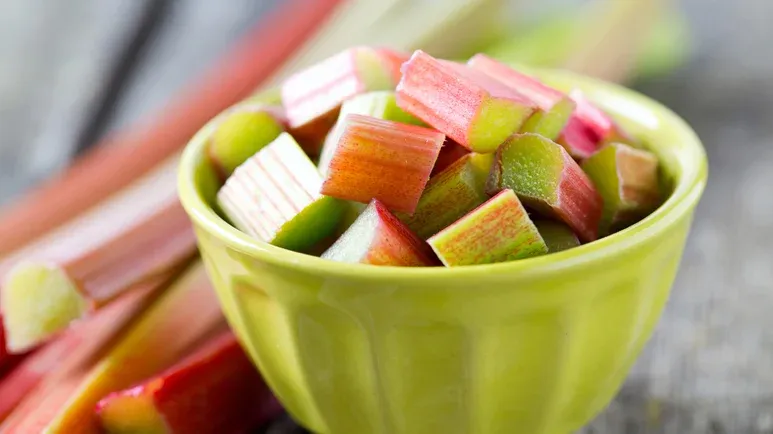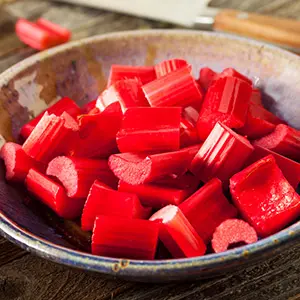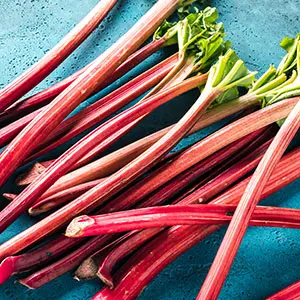Rhubarb: Is This Colorful Veggie Safe for Pets? Read These Tips First
Often mistaken as a fruit, the stalks of this springtime veggie are edible. If your furry friend consumes a small amount of cooked rhubarb stalks, it's no reason to be concerned. However, its leaves can pose a substantial risk and should always be kept out of your pet's reach.

STORY AT-A-GLANCE
- Rhubarb is known for its fleshy, pink-red stalks that resemble a celery, and is often used to make pie filling
- A study notes that rhubarb’s bioactive compounds exhibit “antioxidant, anticancer, antimicrobial, antidiarrheal, antidiabetic, anti-inflammatory, diuretic, hepatoprotective activities, and much more”
- While rhubarb stalks are safe to eat, its leaves are not, which frequently leads to confusion regarding its safety for pets
- Keep the leaves away from pet’s reach at all times. Consuming small amounts of cooked rhubarb stalks is safe for pets
- Rhubarb offers its own array of natural active ingredients that are beneficial for both humans and animals, exerting various pharmacological properties such as antioxidant, anti-inflammatory and anticancer, among others
Editor's Note: This article is a reprint. It was originally published May 16, 2024.
Prolific in the spring, rhubarb is known for its fleshy, pink-red stalks that resemble celery. Often used to make pie filling, it partners harmoniously with strawberries, another springtime favorite whose sweetness counterbalances rhubarb’s tangy notes. But beyond being a “pie plant,” rhubarb also shines in jams, compotes, pastries and even in salads and salsas.1
However, before you indulge in rhubarb, there are some caveats you need to keep in mind, especially if you’re thinking of sharing it with your pet.
Rhubarb Fun Fact

Although rhubarb is technically a vegetable, the U.S. Department of Agriculture classified it as a fruit back in 1947 to lower the taxes on imported rhubarb, as vegetables used to be subject to higher tariffs.2,3
What Is Rhubarb?
Rhubarb (Rheum rhabarbarum) is an herbaceous perennial that belongs to the buckwheat (Polygonaceae) plant family. It can grow up to 4 feet tall, with large heart-shaped leaves.4 The plant was initially valued for its medicinal properties, particularly for its roots’ mild laxative effects.5
The Romans used to import it from Northern Russia, across the Rha River. Since the area lay outside of the Roman Empire, it was considered barbarian land. Because of this, the Romans called rhubarb “rha barbarum” — a term that eventually evolved into its modern name.6
Rhubarb was introduced to the U.S. in the late 1700s, where it was also initially used for medicinal applications. It wasn’t until the 1800s that rhubarb stalks began to be used in food recipes, particularly in European cuisines.7 Nowadays, rhubarb continues to be cultivated across Asia and Europe, as well as some parts of U.S.8
Rhubarb Stalks Are Edible
Interestingly, while rhubarb stalks are edible, the leaves are not — this is what often sparks confusion about rhubarb’s safety.
Misinformation about many healthy fruits, vegetables, nuts and seeds abounds on the internet. This is because websites have labeled all risks (such as the risk of overconsumption causing gastrointestinal issues) as risks or "toxicities," which isn't true but has managed to confuse millions of pet lovers, nonetheless.
In the case of rhubarb, you may have seen websites warning against feeding it to your pet and categorizing it as poisonous for containing soluble oxalate crystals. However, the reality is more nuanced. According to Pet Poison Helpline, “The leaves contain soluble oxalate crystals, with less of the crystals being prevalent in the stalk. That’s why rhubarb stems are edible, but the leaves are not.”9
“Keep the leaves away from their reach. It is not cause for concern if your pet consumes small amounts of the stalk.”
Fortunately, pets are typically not interested in rhubarb leaves, as they taste bitter. Rhubarb stalks are also sold in supermarkets with their leaves removed. But to ensure your pet’s safety, if you have a rhubarb plant at home, make sure your pet does not have access to it. If ingested in large enough quantities, the oxalate crystals in the leaves can cause kidney problems and symptoms such as drooling, vomiting, diarrhea, lethargy, weakness, tremors and changes in appetite, thirst and urination.10
Rhubarb Contains a Diverse Array of Bioactive Compounds
Polyphenols are potent compounds uniquely obtained from plant-based foods. Like other plant-based foods, rhubarb offers its own array of natural active ingredients that are beneficial for both humans and animals.11
According to an article published in Reference Series in Phytochemistry,12 rhubarb’s bioactive compounds exhibit “antioxidant, anticancer, antimicrobial, antidiarrheal, antidiabetic, anti-inflammatory, diuretic, hepatoprotective activities, and much more.” Moreover, a study published in LWT — Food Science and Technology, which sought to identify the polyphenols in rhubarb, found 22 phenolic compounds in it, including “four anthocyanins and phenolic acids, five flavan-3-ols and nine flavonol derivatives.”13
One of the phenolic acids found in rhubarb is gallic acid,14 which a study published in Frontiers in Immunology shows may help alleviate “oxidative stress and inflammatory response in stressed puppies by causing beneficial shifts on gut microbiota and metabolites that may support gut and host health.”15
Other compounds in rhubarb with anti-inflammatory and antioxidant properties are the flavan-3-ols procyanidins, catechins and epicatechins.16,17 As for its flavonol content, rhubarb contains myricetin and quercetin,18 which have powerful antioxidant and anticancer properties.19 Studies have shown that both these compounds may help suppress and control the progression of canine osteosarcoma,20,21 however, vets recommend you supply these potent plant compounds with foods other than large amounts of rhubarb.
Did You Know?

You can actually hear rhubarb grow. A traditional method used in northern England to grow forced rhubarb makes the plant grow at such a quick rate (up to 1 inch or more a day) that its stalks can be heard making squeaking and popping sounds. This method not only extends rhubarb’s growing season but also produces a sweeter yield.22,23
Other Beneficial Nutrients in Rhubarb
Aside from polyphenols, rhubarb also contains vitamins and minerals. It’s particularly rich in vitamin K,24 with one stalk (51 grams) containing 14.9 micrograms of this nutrient.25 Vitamin K is essential for supporting healthy bones26 and normal blood coagulation.27
The same serving of rhubarb also contains 4.08 milligrams of vitamin C,28 a potent antioxidant, as well as 31.1 micrograms of beta-carotene (pro-vitamin A),29 which may help improve your immune health.30 Rhubarb is also an excellent source of insoluble dietary fiber,31 which may help improve your digestive health.32
According to a study published in the Journal of Food Composition and Analysis, boiling the rhubarb stalks in water significantly reduced its soluble oxalate content.33 Cooking rhubarb in milk after boiling it in water can further reduce the oxalate content by 70.3%.34
If your pet has a genetic predisposition to calcium oxalate bladder stones, or a history of calcium oxalate issues, restrict their consumption of oxalate-containing foods to less than 2% of their food intake and don’t offer rhubarb as a treat.
Which States Produce the Most Rhubarb?

In the U.S., rhubarb is grown in the field and in hothouses. There’s about 1,200 acres of rhubarb cultivation, with the majority of production concentrated in Washington, Oregon, and Michigan.35

Is Rhubarb a Sustainable Crop?
According to HeaLabel, rhubarb production is relatively sustainable, causing no significant damage to air, water, land or soil. It has a low water footprint, requiring 322 liters of water to produce a 1 kilogram yield. It also has a low carbon footprint, producing 1.6 kg CO2e per 1 kilogram, which is equivalent to a car driving 3.75 miles or 6 kilometers.36
To make sure that the rhubarb you’re getting is truly sustainable and safe from harmful agricultural chemicals, buy organic, spray-free varieties from a trusted source or from your local farmers market, whenever possible, and primarily serve this summertime favorite to your two-legged family members, not pets.
Sources and References
- 1,8 The Spruce Eats, April 28, 2023
- 2 Huffpost, June 9, 2015
- 3 Food Network, October 27, 2021
- 4 Wisconsin Horticulture, Rhubarb, Rheum rhabarbarum
- 5,13,14,18,19 LWT - Food Science and Technology. 118(2020) 108775
- 6,7 The Sunday Post, February 3, 2017 (Archived)
- 9,10 Pet Poison Helpline, Rhubarb
- 11 LWT, Volume 118, January 2020, 108775, Introduction
- 12 Bioactive Compounds of Rhubarb (Rheum Species). Reference Series in Phytochemistry. July 20, 2021
- 15 Front Immunol. 2022 Jan 14:12:813890
- 16 Molecules. 2022 May 4;27(9):2932
- 17 Science Direct, Epicatechin
- 20 J Cell Physiol. 2018 Sep;233(9):7457-7466
- 21 J Cell Biochem. 2019 Oct;120(10):17449-17458
- 22 Atlas Obscura, April 10, 2018
- 23 Food Republic, July 8, 2023
- 24 PennState Extension, August 30, 2023
- 25,28,29 USDA Food Data Central, Rhubarb, Raw (Archived)
- 26 J Osteoporos. 2019 Dec 31;2019:2069176
- 27 Food Nutr Res. 2012 Apr 2;56:10.3402/fnr.v56i0.5329
- 30 J Vet Intern Med. 2003 Nov-Dec;17(6):835-42
- 31 Nutrition Research. Volume 13, Issue 9, September 1993, Pages 1017-1024
- 32 Today's Veterinary Practice, December 23, 2016
- 33,34 Journal of Food Composition and Analysis. Volume 94, December 2020, 103648
- 35 Michigan State University, March 16, 2023
- 36 ShopLogic, January 3, 2025











